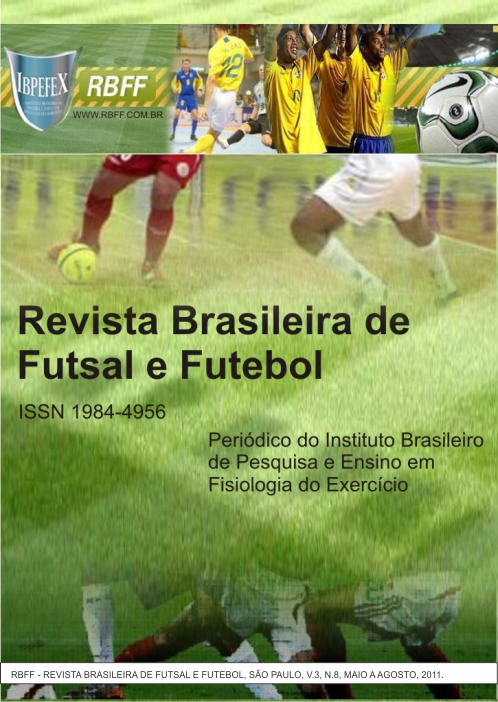Tactical systems: Analysis of the use and effectiveness in the Games of Copa América of Football 2011
Abstract
Introduction and objective: The football teams organization forms is an important factor and influences the performance. Different football schools developed different systems of play and strategical forms, being internationally known. Since the beginning of the football practice, various ways of distribution of players in field had been tested and some of it, consolidated until the current days. From the WM, of Chapman, in 1925, structural modifications had been made and specific tactical systems had been created. This study aims to verify the use of the tactical systems and its effectiveness in the matches of the Copa America de Futebol 2011. Materials and Methods: this is a statistics descriptive analysis study. All the official matches of Copa America de Futebol 2011 had been analyzed and the data gotten through the match analysis software Data Factory (official analyser of South American Football Confederation -Conmebol) computed in spread sheets developed in software Mcrosoft Excel 2010. Results and Discussion: it was observed that the defensive systems had been less used, showing an establishment of offensive concepts of game, and that the systems that hás a great concentration of players in the defensive sectors of the field, had been the ones that presented biggers percentile values for defeat, demonstrating that it does not have evidences that defensive tactical systems are satisfactory in what refers to the result of the match. Conclusion: there is no evidences that prove the importance and relevance of an exclusive and independent factor to guarantee the victory result on football.
References
-Cano, J.B. Manual Del Fútbol. Barcelona. Editorial Hispano Europea. 1973.
-Carravetta, E. O jogador de futebol. Técnicas, treinamento e rendimento. Porto Alegre. Editorial Mercado Aberto. 2001.
-Coelho, P.V. Os 50 maiores jogos da copa do mundo. São Paulo. Panda Books. 2006.
-Ferreira, R.B.; Paoli, P.B.; Costa, F.R. Proposta de scout tático para o futebol. EFDeportes.com. Ano 12. Núm. 118. 2008.
-Giulianotti, R. Sociologia do Futebol. Dimensões históricas e socioculturais do esporte das multidões. São Paulo. Nova Alexandria. 2002.
-Godik, M. Futebol Preparação dos futebolistas de alto nível. Rio de Janeiro. Editora Grupo Palestra Sport. 1996.
-Herbst, D. Soccer. How to play the game. The official Playing and Coaching Manual of the United States Soccer Federation. New York. Universe Publishing. 1999.
-Lauffer, R.; Kater, A. Women ́s Soccer –techniques, tactics & teamwork. New York. USA. Sterling Publishing Company. 2001.
-Leães, C. Futebol -Treinamento em Espaço Reduzido. Porto Alegre. Editora Movimento. 2003.
-Melo, R. Sistemas e Táticas para Futebol. 2ª edição. Rio de Janeiro. Sprint. 2000.
-Parreira, C.A. Evolução Tática e Estratégias de Jogo. 1ª Edição. Brasília. Escola Brasileira de Futebol. 2005.
-Rocha, R.A.S.G. Análise da evolução dos sistemas táticos do futebol brasileiro. Revista Brasileira de Ciências da Saúde. Vol. 8. Núm. 26. 2010.
-Santos, E. Caderno técnico-didático: futebol. Brasília. MEC. 1979.
-Silva, P.R.S. e colaboradores. Avaliação funcional multivariada em jogadores de futebol profissional: uma metanálise. Acta Fisiátrica. Vol. 4. Núm. 2. p. 65-81. 1997.
-Tostão. Tostão: Lembranças, Opiniões, Reflexões sobre Futebol. 1ª Edição. São Paulo. Dorea Books. 1997.
Authors who publish in this journal agree to the following terms:
- Authors retain the copyright and grant the journal the right of first publication, with work simultaneously licensed under the Creative Commons Attribution License BY-NC which allows the sharing of the work with acknowledgment of the authorship of the work and initial publication in this journal.
- Authors are authorized to enter into additional contracts separately for non-exclusive distribution of the version of the work published in this journal (eg, publishing in institutional repository or book chapter), with acknowledgment of authorship and initial publication in this journal.
- Authors are allowed and encouraged to post and distribute their work online (eg, in institutional repositories or on their personal page) at any point before or during the editorial process, as this can bring about productive change as well as increase impact and impact. citation of published work (See The Effect of Free Access).





